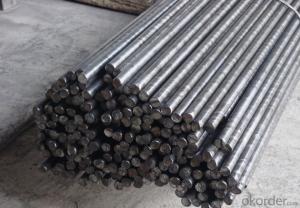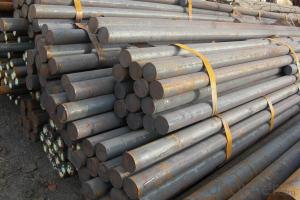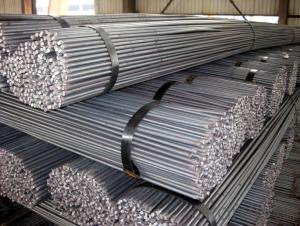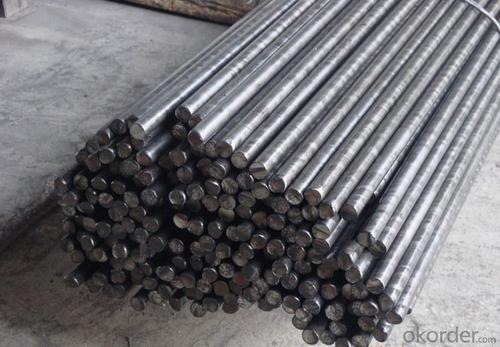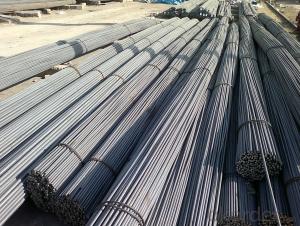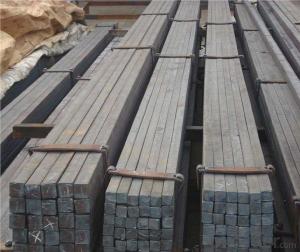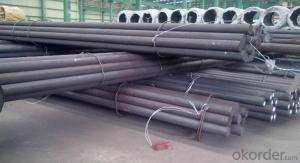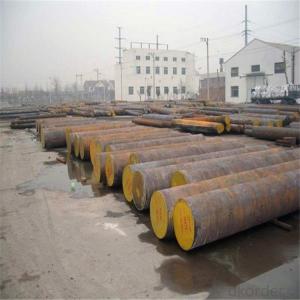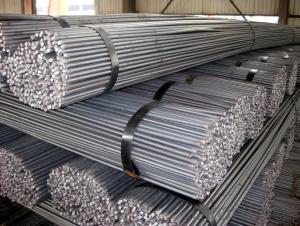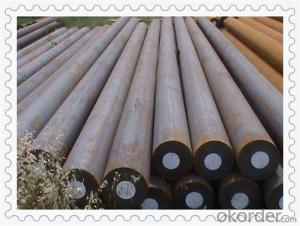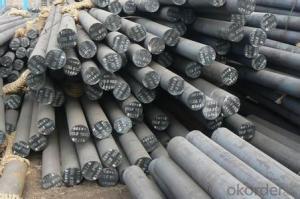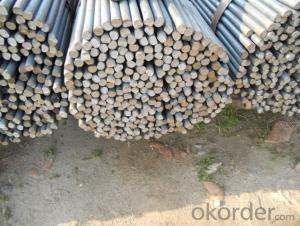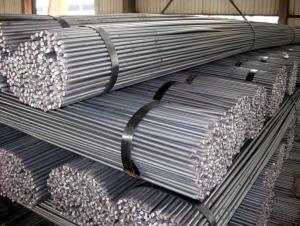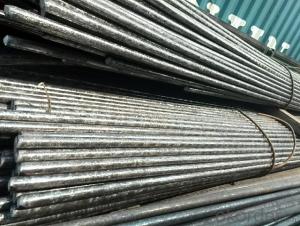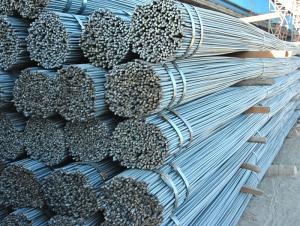Hot Rolled Mild Round Steel Bar Q235, SAE1020,SAE1045
- Loading Port:
- Shanghai
- Payment Terms:
- TT or LC
- Min Order Qty:
- 25 m.t.
- Supply Capability:
- 200000 m.t./month
OKorder Service Pledge
OKorder Financial Service
You Might Also Like
Product Description:
OKorder is offering Hot Rolled Mild Round Steel Bar Q235, SAE1020,SAE1045 at great prices with worldwide shipping. Our supplier is a world-class manufacturer of steel, with our products utilized the world over. OKorder annually supplies products to European, North American and Asian markets. We provide quotations within 24 hours of receiving an inquiry and guarantee competitive prices.
Product Applications:
Hot Rolled Mild Round Steel Bar Q235, SAE1020,SAE1045 are ideal for structural applications and are widely used in the construction of buildings and bridges, and the manufacturing, petrochemical, and transportation industries.
1. Chinese standard steel bar is often used where large amounts of steel need to be formed, for example as structural steel.
2. And we can use this kind of product on the performance of the mechanical parts if the demand is not very high.
3. Steel round bar is used in construction and a large number of architectural and engineering structures.
Product Advantages:
OKorder's Hot Rolled Mild Round Steel Bar Q235, SAE1020,SAE1045 are durable, strong, and resist corrosion.
Main Product Features:
· Premium quality
· Prompt delivery & seaworthy packing (30 days after receiving deposit)
· Corrosion resistance
· Can be recycled and reused
· Mill test certification
· Professional Service
· Competitive pricing
Specifications of Hot Rolled Mild Round Steel Bar Q235, SAE1020,SAE1045
1. Grade: Q195, Q235, Q345
2. Diameter: 6mm-150mm
3. Length: 6m, 9m, 12m or as customer’s request
4. Tolerance: Within ±5% for weight; ±2mm for diameter
5. Note: The price can be better is the quantity is good
6. Chemical composition
Alloy No | Element (%) | ||||
C | Mn | S | P | Si | |
Q195 | 0.06-0.12 | 0.25 | ≤0.05 | ≤0.045 | ≤0.3 |
Q235 | 0.12—0.20 | 0.3—0.7 | ≤0.045 | ≤0.045 | ≤0.3 |
Q345 | ≤0.2 | 1.00-1.60 | ≤0.045 | ≤0.045 | ≤0.55 |
Packaging & Delivery of Hot Rolled Mild Round Steel Bar Q235, SAE1020,SAE1045
Packaging Detail: All goods are packed in bundle with steel strips and shipped by break bulk vessel or container (depend on target market and different ports)
Delivery Detail: 45 days
Trade terms: FOB, CFR, CIF
MOQ: 25 tons per specification; we can negotiate the quantity if the specification is normal or we have stock of one specification.
Weight: Theprice invoicing on theoretical weight basis or actual weight basis depends on customer’s request.
Shipment: The shipment of bulk break or container is depends on customer’s request and the situation of the port of destination.
Documents given: Full set of original clean on board bill of lading; Original signed commercial invoice; Original packing list; Policy of insurance; Certificate of origin and what the target market needs.
Production Flow of Hot Rolled Mild Round Steel Bar Q235, SAE1020,SAE1045
1. The common processes are preheated forging quenching, dual refinement solution process, cooling quenching and isothermal quenching. We use heat treatment for dual refinement solution process.
2. Material prepare (billet) — heat up — rough rolling — precision rolling — cooling — packing — storage and transportation
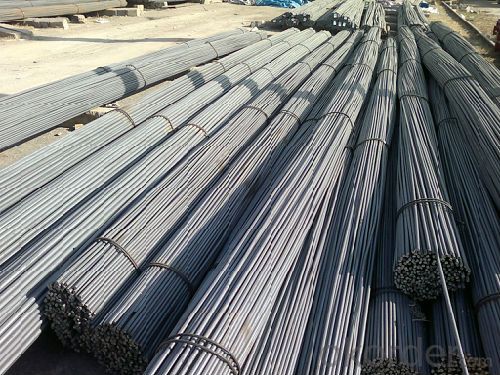
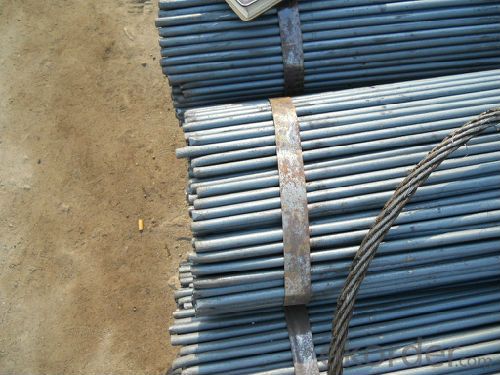
FAQ:
Q1: Can fit in the containers of 20fts Hot Rolled Mild Round Steel Bar Q235, SAE1020,SAE1045 of 6M?
A1: No proble, we can put them into the containers in the form sideling.
Q2: How soon can we receive the product after purchase?
A2: Within three days of placing an order, we will begin production. The specific shipping date is dependent upon international and government factors, but is typically 7 to 10 workdays.
Q3: How do we guarantee the quality of our products?
A3: We have established an advanced quality management system which conducts strict quality tests at every step, from raw materials to the final product. At the same time, we provide extensive follow-up service assurances as required.
- Q: Can steel round bars be bent or formed?
- Steel round bars have the capability to be bent or formed, depending on several factors such as the type of steel, bar diameter and thickness, and the chosen bending or forming method. There are various techniques available for bending or forming steel round bars, including hot bending, cold bending, and mechanical bending. In hot bending, the steel round bar is heated to a specific temperature and then shaped according to the desired form. On the other hand, cold bending does not require any heating and can be accomplished using hydraulic or manual bending machines. Mechanical bending, however, involves the utilization of specialized machinery to apply force and bend the steel round bar. It is vital to note that excessive bending or forming may weaken the steel round bar and affect its structural integrity. Hence, it is crucial to adhere to proper bending and forming techniques and consider the manufacturer's limitations and industry standards.
- Q: Can steel round bars be used in the production of medical equipment?
- Yes, steel round bars can be used in the production of medical equipment. Steel is a common material used in the manufacturing of medical devices and equipment due to its strength, durability, and versatility. Steel round bars can be used to create various components of medical equipment such as surgical instruments, orthopedic implants, diagnostic tools, and hospital furniture. The properties of steel, such as its resistance to corrosion and ability to be sterilized, make it a suitable choice for use in the medical industry where hygiene and patient safety are of utmost importance. Additionally, steel round bars can be easily machined and fabricated into different shapes and sizes, allowing for the customization of medical equipment to meet specific requirements.
- Q: Are steel round bars suitable for decorative purposes?
- Yes, steel round bars can be suitable for decorative purposes. They can be used in various architectural and interior design applications to create a modern and industrial aesthetic. Steel round bars can be shaped, polished, or painted to enhance their decorative appeal and add a stylish touch to furniture, fixtures, sculptures, and other artistic creations.
- Q: Are steel round bars suitable for bridge construction applications?
- Yes, steel round bars are suitable for bridge construction applications. Steel is known for its strength, durability, and versatility, making it an ideal material for bridge construction. Steel round bars provide excellent structural support and can withstand heavy loads and harsh environmental conditions. Additionally, steel round bars can be easily fabricated and customized to meet specific bridge design requirements.
- Q: Can steel round bars be used in the automotive industry?
- Indeed, the automotive industry does make use of steel round bars. These bars are frequently employed in various capacities within the industry. Specifically, they are commonly utilized in the fabrication of different components, including axles, drive shafts, suspension parts, and steering components. The reason for their popularity lies in their exceptional attributes, such as high strength, durability, and resistance to wear and tear. These qualities enable them to withstand the rigorous conditions and heavy loads that automotive components are subjected to. Moreover, the ease with which steel round bars can be machined and welded facilitates efficient production and assembly processes in the automotive sector. Consequently, steel round bars are highly regarded as a dependable and cost-effective option for automotive manufacturers, making them a favored material in the industry.
- Q: Can steel round bars be used in the packaging industry?
- Yes, steel round bars can be used in the packaging industry. They are commonly used for constructing pallets, crates, and other packaging materials that require strength, durability, and load-bearing capacity. Steel round bars provide a robust and reliable solution for packaging heavy and bulky items, ensuring safe transportation and storage.
- Q: Are steel round bars available in custom sizes?
- Yes, steel round bars are available in custom sizes.
- Q: What are the advantages of using boron-alloy steel round bars?
- The advantages of using boron-alloy steel round bars include increased strength, improved hardness and wear resistance, enhanced toughness, and better heat resistance. Boron-alloy steel round bars also have excellent machinability and can withstand high temperatures without losing their structural integrity. Additionally, these bars offer cost savings due to their longer service life and reduced maintenance requirements.
- Q: How do you calculate the weight of a steel round bar based on its density and dimensions?
- In order to determine the weight of a steel round bar, one must possess knowledge of its density and dimensions. The weight can be calculated using the formula W = V x D, where W represents weight, V represents volume, and D represents density. Firstly, it is necessary to ascertain the volume of the round bar. The volume of a cylinder can be calculated using the formula V = πr^2h, where V represents volume, π is a constant (approximately 3.14159), r represents the radius of the round bar, and h represents the height or length of the round bar. In the event that one possesses the diameter of the round bar instead of the radius, the radius can be determined by dividing the diameter by 2. Once the radius is determined, it can be substituted into the formula along with the height of the round bar to calculate the volume. Subsequently, knowledge of the density of the steel is required. The density of steel is typically measured in grams per cubic centimeter (g/cm^3) or kilograms per cubic meter (kg/m^3). It is imperative to ensure that the units for both density and volume are consistent. If the density is given in g/cm^3, the volume must be converted from cm^3 to m^3 by dividing it by 1,000,000. Finally, the weight can be calculated by multiplying the volume by the density. If the density is provided in kg/m^3, the weight will be in kilograms. If the density is provided in g/cm^3, the weight will be in grams. Conversion to other units can be achieved by utilizing appropriate conversion factors. It is crucial to verify all calculations and maintain consistency of units throughout the entire calculation process.
- Q: How are steel round bars tested for quality and strength?
- To ensure that steel round bars meet the necessary standards and specifications, various methods are employed to test their quality and strength. One commonly used test is the tensile test, which measures the bar's ability to withstand tension. In this test, a sample of the steel bar is gradually loaded until it reaches its breaking point, and the maximum load it can handle is recorded, along with the sample's elongation and reduction in area. These values offer valuable insights into the bar's strength and ductility. Another test employed is the hardness test, which assesses the steel bar's resistance to indentation or penetration. This test utilizes a hardness testing machine that applies a specific force to a small indenter, such as a diamond or a steel ball, and measures the resulting indentation's depth or size. The obtained hardness values can indicate the bar's strength and its ability to withstand wear and deformation. Apart from these mechanical tests, non-destructive testing methods are also used for steel round bars. Ultrasonic testing is a common technique employed to identify internal defects or inconsistencies in the bar's structure. This method involves transmitting high-frequency sound waves through the bar and analyzing the reflected waves to detect any irregularities. Magnetic particle inspection is another non-destructive test that relies on magnetic fields and particles to identify surface or near-surface defects in the steel bar. Chemical analysis plays a crucial role in determining the quality of steel round bars. This analysis involves testing the steel's composition to ensure it meets the required chemical specifications. It helps identify the presence of impurities or elements that could impact the bar's performance and durability. In summary, steel round bars undergo a combination of mechanical, non-destructive, and chemical tests to evaluate their quality and strength. These tests provide manufacturers with essential information, enabling them to ensure that the bars meet the necessary standards and are suitable for their intended applications.
Send your message to us
Hot Rolled Mild Round Steel Bar Q235, SAE1020,SAE1045
- Loading Port:
- Shanghai
- Payment Terms:
- TT or LC
- Min Order Qty:
- 25 m.t.
- Supply Capability:
- 200000 m.t./month
OKorder Service Pledge
OKorder Financial Service
Similar products
Hot products
Hot Searches
Related keywords
